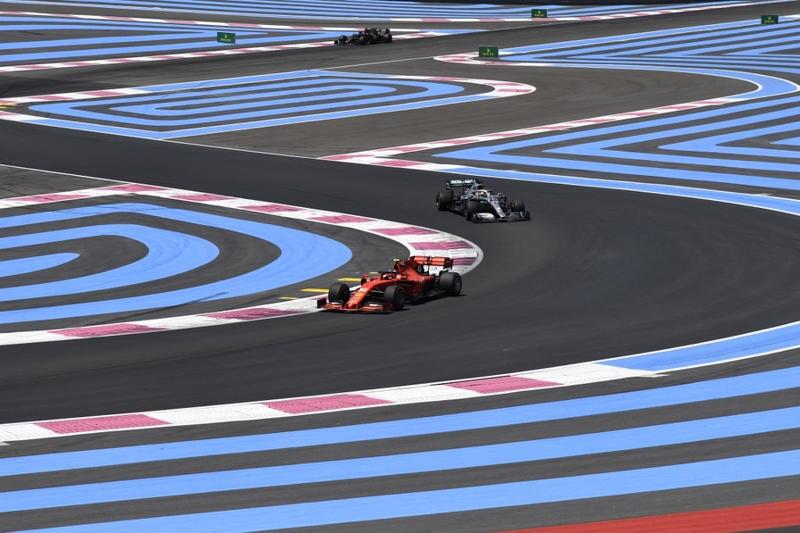 In this June 22, 2019 photo, Ferrari's Monegasque driver Charles Leclerc Mercedes' drives ahead of British driver Lewis Hamilton and HAAS F1 Team's French driver Romain Grosjean during the third practice session at the Circuit Paul Ricard in Le Castellet, southern France ahead of the 2019 Formula One Grand Prix de France. (GERARD JULIEN / AFP)
In this June 22, 2019 photo, Ferrari's Monegasque driver Charles Leclerc Mercedes' drives ahead of British driver Lewis Hamilton and HAAS F1 Team's French driver Romain Grosjean during the third practice session at the Circuit Paul Ricard in Le Castellet, southern France ahead of the 2019 Formula One Grand Prix de France. (GERARD JULIEN / AFP)
LONDON - Formula One could start the season behind locked gates and without spectators due to the COVID-19 pandemic but the glamour sport will likely have to slim down considerably to get the green light to go racing.
Formula One’s hope is that getting some races done, even without a trackside audience, opens up the chance of a proper championship if Asian and Middle Eastern races can go ahead later in the year
Across Europe, bans on mass gatherings and public events have been extended into July and August even as countries begin to emerge from the strict lockdowns that have put sporting activities on hold.
Formula One’s season remains stalled, with seven races postponed so far and organisers talking of a reduced calendar possibly running into January.
ALSO READ: Belgian Grand Prix joins France on F1's uncertain list
The BBC reported on Thursday, after team bosses held an online meeting, that the latest plan was to start behind closed doors in Austria on July 5 and then hold two races at Silverstone, a home venue for seven of the 10 teams.
Racefans.net suggested Silverstone could be on for three races in four weeks and on different layouts.
Formula One’s managing director Ross Brawn indicated earlier this month that radical measures were under consideration.
“We’re looking at the logistics of a closed race, how would we get the people there, how would we protect them, how would we make it safe, who would we allow into the paddock,” he said. “Every permutation is being discussed.”
Austria has said it would not be opposed to a race without spectators, if travel restrictions were lifted and other safeguards enacted.
Red Bull team boss Christian Horner said the Red Bull-owned Austrian circuit in Spielberg could be made ready at very short notice.
“The prospect of being able to run a race behind closed doors is absolutely feasible,” he told Sky Sports television.
“I think there is going to be a staged route back into full-on grands prix and there are certain circuits they are talking to about crowdless events, potentially just focusing on TV events for now with limited numbers of people.”
What is a mass event?
Formula One rules state that each of the 10 teams can have no more than 60 people “who are associated in any way with the operation of the cars” in the paddock.
There are then the Pirelli tyre fitters, FIA technicians, other key suppliers, Formula One employees, broadcasters and media as well as track and medical staff running into the hundreds.
Broadcast personnel range from some 40-45 typically attending for Britain’s Sky Sports television to half that number for Sky Italia and as few as eight for Sky Germany.
“The operational personnel is pretty much defined by the regulations,” McLaren team principal Andreas Seidl told reporters on Wednesday.
“I don’t think it will be much different compared to normal race events because we simply need all the people in order to operate the cars, to service them during the weekend and to race them and do the pitstops.”
Formula One sources said detailed conversations were ongoing with teams to bring the numbers down to bare bones, with media access likely to be restricted to ensure safe spacing. Team marketing and sponsors would have to stay away.
How feasible a just-for-television ‘ghost race’ would be depends also on interpretation.
READ MORE: Canadian GP eyes fall rescheduling
“Even without spectators we would have a lot of people on site to organise the event,” said Belgian Grand Prix commercial director Stijn de Boever, whose country on Wednesday banned mass gatherings until the end of August.
“What is a mass event? Does that mean 500, 3,000 or 5,000 people?”
Formula One’s hope is that getting some races done, even without a trackside audience, opens up the chance of a proper championship if Asian and Middle Eastern races can go ahead later in the year.


